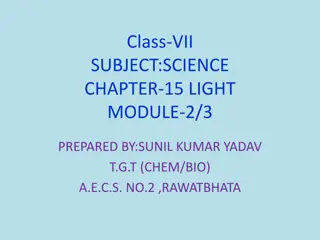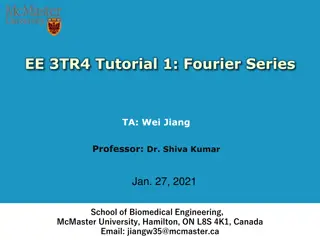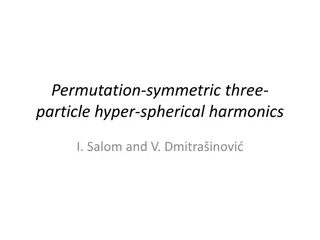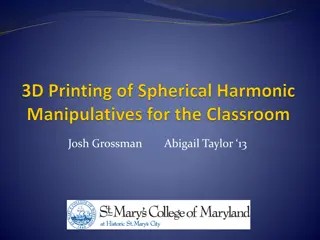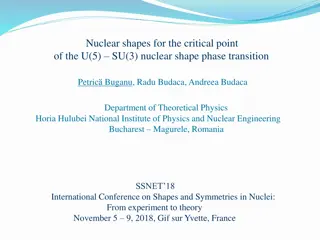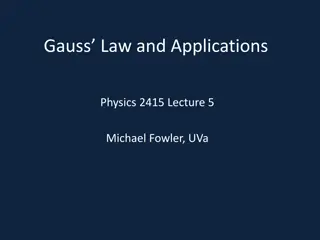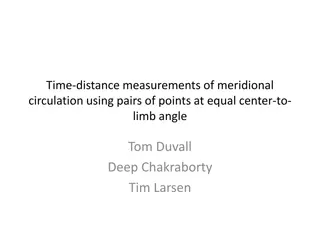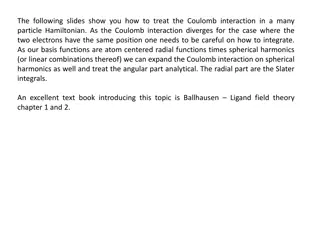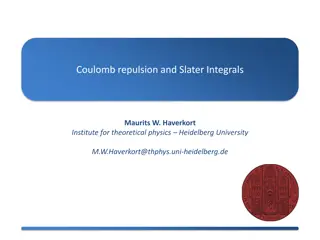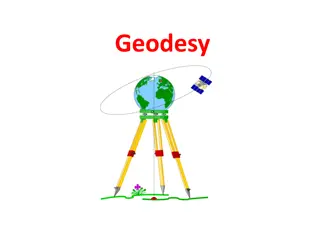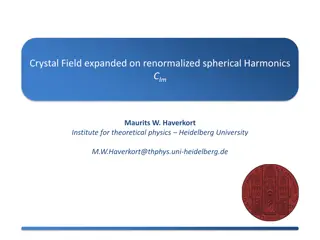Applications of Hyper-Spherical Harmonics in Physics
Explore the utility of hyper-spherical harmonics as a natural basis for solving three-particle wave functions in physics, specifically in areas such as atomic physics, molecular physics, and systems involving three quarks. Learn about their role in reducing the complexity of problems, providing manifest permutation and rotation properties, and accounting for special dynamical symmetries. Dive into the concepts of center-of-mass systems, Jacobi coordinates, SO(6) invariants, hyper-spherical coordinates, and the significance of d-dimensional hyper-spherical harmonics in representing functions on d-dimensional spheres.
- Hyper-Spherical Harmonics
- Three-Particle Systems
- Physics Applications
- Quantum Mechanics
- Symmetry Properties
Download Presentation

Please find below an Image/Link to download the presentation.
The content on the website is provided AS IS for your information and personal use only. It may not be sold, licensed, or shared on other websites without obtaining consent from the author. Download presentation by click this link. If you encounter any issues during the download, it is possible that the publisher has removed the file from their server.
E N D
Presentation Transcript
XI. International Workshop LIE THEORY AND ITS APPLICATIONS IN PHYSICS 15 - 21 June 2015, Varna, Bulgaria SO(6) hyper-spherical harmonics as a natural basis for three-particle wave functions I. Salom and V. Dmitra inovi Institute of Physics, University of Belgrade
Solving two particle problems Typical example Hydrogen atom Using center-of-mass reference system where a single 3-dim vector determines position Split wave function into radial and angular parts Using basis of spherical harmonics for the angular wave function (essential)!
Goal in 3-particle case Use c.m. system, reducing number of fr. deg. from 9 to 6 Split the problem into radial and hyper-angular parts Solve angular part by decomposition to (hyper)spherical harmonics! Additional requirements/wanted properties: Harmonics provide manifest permutation and rotation properties Account for certain special dynamical symmetries Applications: three quark systems, molecular physics, atomic physics (helium atom), positronium ion
Center-of-mass system Jacobi coordinates: In the case of different masses coordinates are more complicated Non-relativistic energy SO(6) invariant:
Hyper-spherical coordinates Triangle shape-space parameters: Smith-Iwai Choice of angles Plus angles that fix the position/orientation of the triangle plane (some 1, 2, 3 )
6 dim spherical harmonics = ??? Let us recall a few facts about standard 3D s.h. Functions on sphere: UIR of UIR of Orthogonal: E.g.:
D-dim hyper-spherical harmonics Intuitively: natural basis for functions on D-dim sphere Functions on SO(D)/SO(D-1) transform as traceless symmetric tensor representations (only a subset of all tensorial UIRs) UIR labeled by single integer K, highest weight (K, 0, 0, ) <=> K boxes in a single row <=> K(K+D-2) quadratic Casimir eigenvalue Homogenous harmonic polynomials (obeying Laplace eq. = traceless) of order K restricted to unit sphere Harmonics of order K are further labeled by appropriate quantum numbers, usually related to SO(D) subgroups
Decomposition Complex Jacobi coord.: Y-string potential = the shortest sum of string lengths function of triangle area SO(3) rotations SO(6) U(3)
Quantum numbers E.g. this can be or often used operator Labels of SO(6) hyper-spherical harmonics U(1) SO(6) multiplicity SU(3) SO(3) SO(2)
Core polynomials Building blocks two SO(3) vectors and Start from polynomials sharp in Q: Define core polynomials sharp in J, m and Q: Core polynomial certainly contains component with but also lower K components
Harmonizing polynomials Let be shortened notation for all core polynomials with K values less than some given Harmonic polynomials are obtained as ortho- complement w.r.t. polynomials with lesser K, i.e.: whereare deduced from requirement: Scalar product of core polynomials
Scalar product of polynomials on hyper-sphere Defined as it can be shown that: that for core polynomials eventually leads to a closed-form expression Integral of any number of polynomials can be evaluated (e.g. matrix elements)
Multiplicity E.g. this can be or often used operator Exist nonorthogonal and Degenerated subspace: We remove multiplicity by using physically appropriate operator and obtain orthonormalized spherical harmonic polynomials as: where and U is a matrix such that:
Now we can explicitly calculate harmonics in Wolfram Mathematica
Particle permutations Transformations are easily inferred since:
leading to definite transformation properties of h.s. harmonics: 1) Transposition is pure sign: 2) 3)
Now we solve problems by h.s.h. decomposition Schrodinger equation coupled d.e. in : : where: In the first order p.t. this can be diagonalized into:
Realistic symmetric potentials effectively have only few harmonics! So that energy and ordering of the states depend only on a few coefficients.
State orderings Delta potential state ordering for K=4: Fixed state ordering for K=2:
Hyper-spherical coordinates Triangle shape-space parameters: Smith-Iwai Choice of angles Plus angles that fix the position/orientation of the triangle plane (some 1, 2, 3 )
I - Case of planar motion 4 c.m. degrees of freedom - Jacobi coordinates: or spherically R, , and conjugated to overall angular momentum Hyper-angular momenta so(4) algebra:
Decomposition: Y-string potential = the shortest sum of string lengths function of triangle area
Hyper-spherical harmonics Labeled by K, L and Q: Functions coincide with SO(3) Wigner D- functions: Interactions preserve value of L (rotational invariance) and some even preserve Q (area dependant like the Y-string three-quark potential)
Calculations now become much simpler We decompose potential energy into hyper- spherical harmonics and split the problem into radial and angular parts:
II - Case of 3D motion 6 c.m. degrees of freedom - Jacobi coordinates: or spherically R, , and some 1, 2, 3 Tricky! Hyper-angular momenta so(6) algebra:
Particle permutations Transformations are easily inferred since:
Goal in 3-particle case Use c.m. system and split the problem into radial and angular parts Interaction is not radial-only, but in all realistic interaction potentials radial component is dominant starting point for perturbation approach Solve angular part by decomposition to (hyper)spherical harmonics Account for some special dynamical symmetries (e.g. Y-string three-quark potential) Harmonics provide manifest permutation and rotation properties Applications: three quark systems, molecular physics, atomic physics (helium atom), positronium ion


